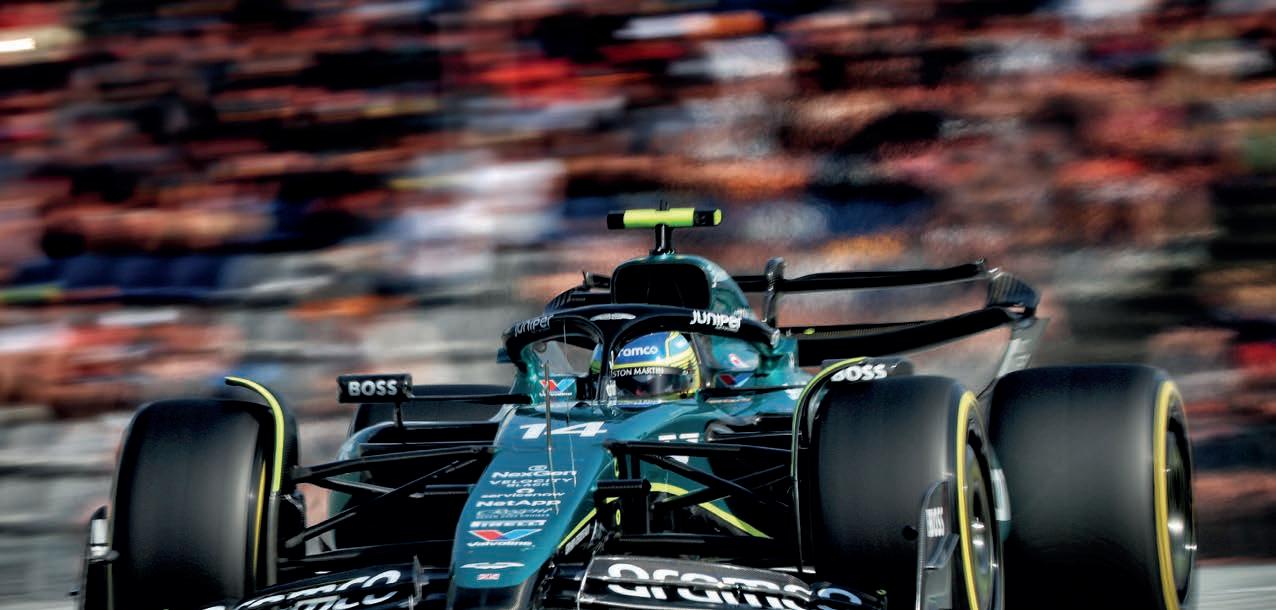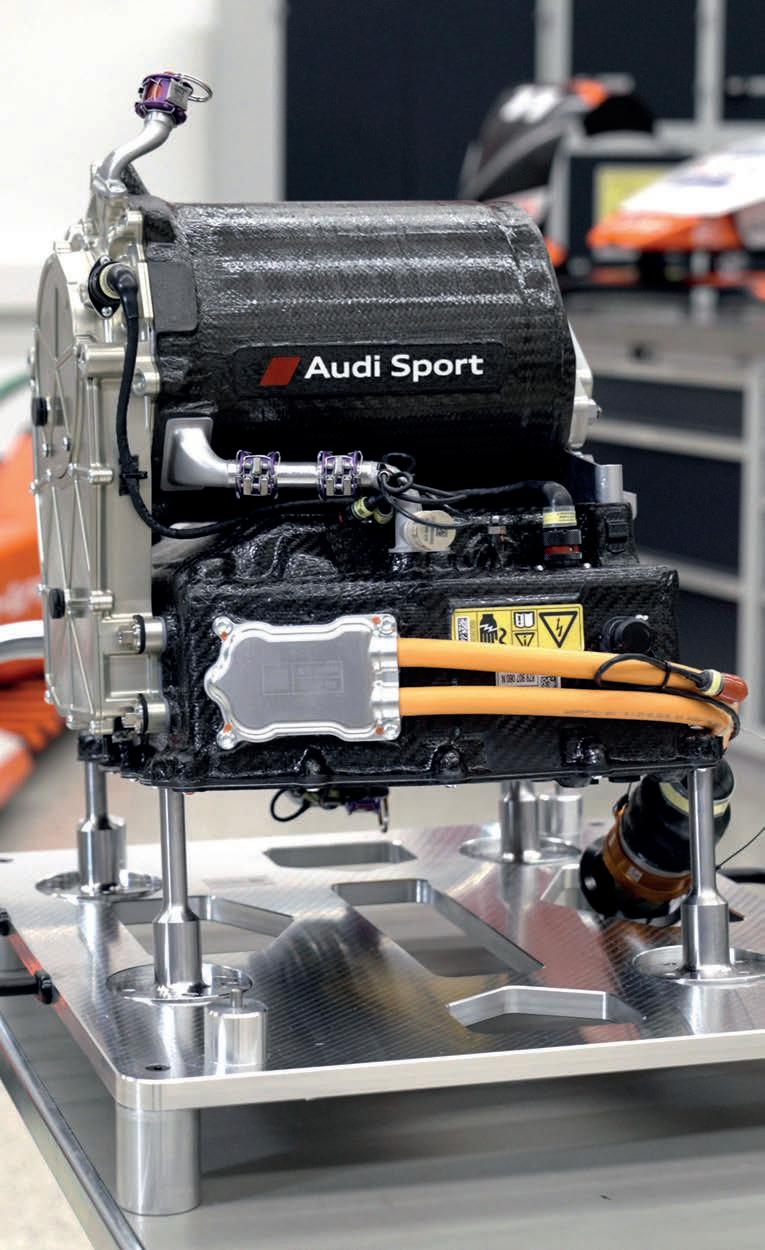




















































Dan Fallows on how Formula 1 team can deliver success in 2025 and beyond



Hypercar evolution



Porsche and BMW reveal development programmes that led to wins and titles


Small but quick

Brands Hatch plays host to the search for the world’s fastest Mini


HEAT MANAGEMENT
Coping with the side e ects of electric powertrains

POWER ELECTRONICS
Drive for e ciency in racing’s e-motor technology





HISTORY AT INDIANAPOLIS
Albert H Stein’s 1966 twin-engined special


Aston Martin has been isolated in the middle of the F1 standings, but could its aggressive expansion plan help transform it into a title winner?
By DANIEL LLOYD



It has been a disparate season for the Aston Martin Formula 1 team. On the one hand, its Mercedes-powered AMR24 has underperformed. The car became marooned in fth place in the World Constructors’ Championship, unable to break into the top four that its predecessor accessed so spectacularly for part of last year. On the other hand, it has been an exciting period o -track, as team owner Lawrence Stroll’s ambitious vision to create a title-winning organisation continues to take shape. The sparkling new factory at Silverstone is growing by the week, and the building blocks of an all-star technical leadership structure have fallen into place, headlined by the signing of former Red Bull Racing chief technical o cer, Adrian Newey.
The disparity between a challenging year on the track and a thrilling one o it helps visualise just how tough it is to reach the upper echelon of F1. It also demonstrates the bigger picture at play.
The gap to the leading teams can now be expected to close, based on the wider changes being carried out as part of Stroll’s uncompromising pursuit of excellence.
The AMR24 was the rst car to be designed and built in Building One of the new Aston Martin Racing Technology Campus, which opened last year for an initial cohort of 700 sta . It was developed during a period of infrastructural transition, as Aston Martin was still using the Mercedes wind tunnel located 10 minutes down the road in Brackley. Nonetheless, it bene ted from newer design facilities and systems than those housed in the old base, situated in the same elds opposite Silverstone’s entrance, which was rst built for Jordan in 1992.

When the AMR24 was launched in mid-February, Aston Martin F1 technical director, Dan Fallows, said the team wanted to ‘broaden the car’s operating window’
and make it ‘more of an all-rounder.’ The previous year’s contender, the AMR23, made a stunning start, especially in the hands of Fernando Alonso, who achieved six podiums in the rst eight races. However, its performances tailed o as the season progressed and some upgrades yielded undesired traits, although Alonso still held it together and nished fourth in the Drivers’ Championship.
Aston Martin’s primary goal for this year, then, was to make the AMR24 perform with greater consistency at a wider variety of tracks, although that does not necessarily lead to an outright faster car. The AMR24 initially proved a reliable scorer, taking 44 points in the rst seven races (many of which had lots of high-speed corners) but it wasn’t giving the likes of Red Bull, Ferrari, McLaren and Mercedes anywhere near the amount of trouble the AMR23 did. At time of writing, Alonso’s fth place at round two in Saudi Arabia was the car’s best result of the season.


In 2024, instead of battling for podium positions, Aston Martin has found itself scrapping for the small points against the likes of Haas, Williams and Alpine


Hendrick Motorsports produces over 600 NASCAR engines per year as it bids to reach 600 pro race wins
By ANDREW COTTON
Anyone who has been to Hendrick Motorsports’ campus cannot fail to be impressed. Housed on 140 acres in Charlotte, North Carolina, the facility runs up Papa Joe Hendrick Boulevard to a series of factories that has steadily grown in size from 5000ft.sq in 1984 to an incredible 430,000ft.sq today.
On site is a full race shop for teams competing in various NASCAR-sanctioned championships, a museum that celebrates the 40-year history of the team, and a state-of-the-art engine facility that produces one of the highest number of bespoke power units per season in world motorsport.
Since April 1984, when Geoff Bodine won the NASCAR Cup Series race at Martinsville, products of the engine shop have powered winners every year, bar 1985. In the middle of this year, Hendrick driver, Kyle Larson, racked up the team’s 310th victory when he took the chequered flag at Indianapolis, while further wins in the second-tier NASCAR Xfinity Series and the NASCAR Truck Series added to the impressive tally and have taken the company’s record beyond 500 professional race wins. The next goal, then, is to hit 600.


The Fastest Mini in the World competition has been attracting the most extreme examples of the famous city car for 30 years now. Racecar considers the top contenders at the 2024 event
By MIKE BRESLIN



When the Mini was launched in 1959, it was seen as what we now call a city car, something cute, cheap and convenient for pootling around town. What it was not seen as was a formidable competitor on a race circuit or rally stage. The cheeky little car was having none of that, though, and was quickly mixing it with the big boys, and winning, in both races and rallies.
Sports versions such as the Cooper were soon in production, while tuning companies dedicated to getting the maximum from Alec Issigonis’ minimalist design proliferated, until the Mini was seen as the quintessential small competition car.
Meanwhile, the cars themselves just became faster and faster, many ying the ag high for front-wheel drive in special saloons and similar categories.
The spirit of the competition is really about trying to get the most from the front-wheel drive format of the original car

That development has never stopped, even when production of the original Mini ceased in 2000. The reason for this is partly the car’s fanatical worldwide following, but also because for the last 30 years there has been an annual race event called the Fastest Mini in the World (FMitW). It caters solely for the old-style Mini, which in a motorsport universe of ‘formula this’ and ‘class that’ is a refreshingly just-what-it-says-on-the-tin title.
The 2024 edition of FMitW was held at the Mini Festival at Brands Hatch in August.
‘The Fastest Mini in the World is basically for any derivative of the Mini, or silhouette Mini,’ says Nigel Death (pronounced Deeth), the race director, who also competes in a Mini Cooper S in Class D. ‘Within the grid, we run four classes: A, B, C and D. Class A, which has
no engine restrictions, attracts the silhouette, spaceframe cars, the really fast stuff.’
While rear-wheel drive, motorcycleengined Minis have been allowed to compete in the past, the spirit of the competition is really about trying to get the most from the front-wheel drive format of the original car. That said, there are very few restrictions, beyond the usual safety regulations, but there are some spec elements. For instance, FMitW uses Sustain Racing fuel, which means a 35 per cent reduction in emissions, and even a small hike in performance.
‘We’ve got evidence to prove it does make a difference,’ says Death. ‘We put it on the dyno at Swiftune [the renowned British Mini engine builder], and it delivers a 3bhp benefit.’
The event also uses Rowe synthetic oil, which has been proven to work well on the wide range of engines used in FMitW, while
well known parts supplier, Mini Spares, is a ‘massively supportive’ long-time sponsor of the competition, says Death.
This year’s 30th anniversary event attracted the biggest grid in 25 years, with 22 Minis entered, half of which were in the top class. As this is where the winner usually comes from, it makes sense to concentrate on a selection of Class A cars here.
We’ll begin with the car that currently holds the Fastest Mini in the World title, having won both 2024 races, and has done so four times in the past (2015, 2019, 2021 and 2022). It belongs to former Jaguar engineer, Harvey Death, who is organiser Nigel’s brother.
The beautifully presented car has a spaceframe chassis with a T45 rollcage and carbon fibre bodywork. It weighs in at 630kg.



Rod Pobestek’s RP968 World Time Attack challenger has been steadily improving for a decade now. Racecar examines the changes made for 2024, and the results
By DEJAN NINIC

Changes to the Porsche
machine have been incremental in recent years, mainly focusing on aerodynamic e ciency by reducing drag and cleaning up air ow in critical areas
By LAWRENCE BUTCHER

Electri cation is steadily gaining ground in motorsport, mainly via hybridisation, but also through all-electric race series. Regardless of the power mix, both hybrids and pure electric vehicles (EVs) require the use of inverters to control their electric motors, and the development of these devices has been almost as important to performance progression as gains in motor technology.
Control systems for electric motors, be they incorporated into a pure EV or a hybrid drive system, are a key part of ensuring overall powertrain e ciency. The control must be precise, switching current at sometimes very high frequencies and with minimal electrical losses. Losses mean ine ciency and a reduction in the amount of battery energy that reaches the wheels, while also contributing to de cits in other areas of vehicle performance.
For example, an ine cient controller will generate considerable heat, which in turn increases the need for cooling and, in turn, adds to the aerodynamic drag of a vehicle. It is therefore in the interests of anyone developing high-performance electric vehicles to have the most e cient motor controllers possible, while also ensuring they are lightweight and in a compact package.
An inverter converts electricity from a DC (direct current) source – normally a battery, but also in some cases supercapacitors and fuel cells – into AC (alternating current), to drive a motor. DC current is fed to the primary winding of a transformer in the inverter and is ‘sliced’ using an electronic switch, comprising a series of power semiconductors, which these days are either insulated gate bipolar transistors (IGBTs) or metal oxide semiconductor eld e ect transistors (MOSFETs). The electrical charge travels into the transformer’s primary winding, reversing, and then owing back out. The result is an alternating current within the transformer’s secondary winding, which then feeds the motor.
For both racing and road car applications, e ciency is king for both motor and inverter operation. As motor speeds increase (most